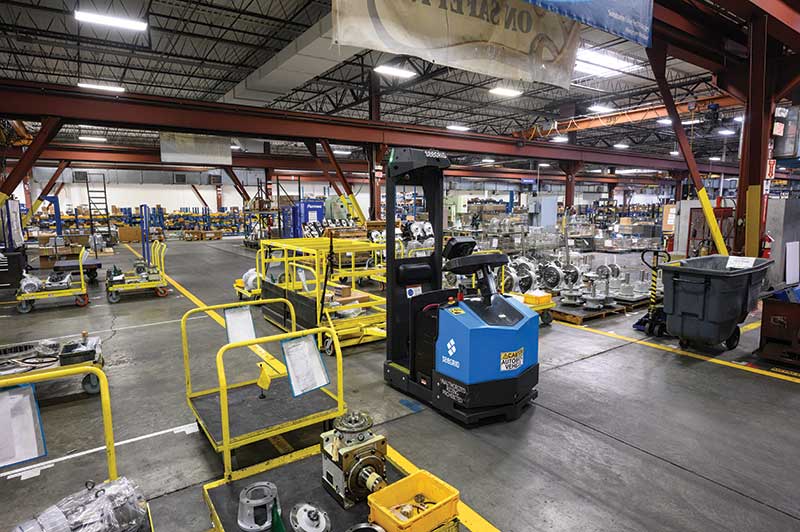Automating inter-facility part moves
Manufacturer taps autonomous tow tractors to automate the hauling of large, heavy parts and equipment to assembly, cutting non-value added activities and enhancing safety in the process.

When most of us think of the application ofautonomous mobile robots (AMRs)in warehousing, it centers on picking or transporting finished goods as part of order fulfillment. But another essential supply chain process can also benefit from larger format AMRs—getting parts and components from a warehouse serving manufacturing to production work cells without consuming lift truck operator labor time.
ForSumitomo Drive Technologies, which makes high quality power transmission products such as gearboxes and gear motors for various applications, including food and beverage, automotive and parcel handling, growth in the Americas market led the company to add a second warehouse to its operations in Chesapeake, Va. The operation made its line-side materials delivery an inter-building workflow, stretching out the distance that needed to be regularly covered.
More specifically, Sumitomo expanded its operational footprint by building an additional 100,000-square-foot warehouse to its existing 250,000-square-foot facility. With the addition, the company needed to haul parts and components from the new warehouse to assembly lines in the other building. The roundtrip for this parts delivery is about 3,000 feet, and when done 30 to 40 times per day using manually operated lift trucks, operator time quickly became consumed by repetitive, non-value activities that were hazard prone.
The operations team sought a solution to find a more efficient line-side delivery system, leading the company to examine an autonomous tow-tractor solution based on AMR technology (Seegrid).
Seegrid automation experts worked collaboratively with the company’s staff to integrate aPalion Tow Tractorinto this inter-facility, parts-to-line material movement. The tow tractor connects to heavy-duty carts that hold the parts needed in production.
Providing hands-on support and training, the supplier helped deploy the solution and made sure the Sumitomo team was confident and comfortable designing AMR routes, making changes and working alongside the AMR.
Since the tow tractor is an AMR with sensors for autonomous navigation and safety, it doesn’t need special guidance infrastructure, and the tow tractor and its load will come to a safe stop if an obstacle gets in the way and then get going again once the route is clear.
Sumitomo also uses the supplier’s fleet management software to monitor and control the AMR material flow. It provides operators full visibility into when materials are en route to production cells and on-demand control to have parts delivered when needed. The automation has freed up the need to have lift truck operators transport heavier loads, or other staff move smaller parts on foot with smaller carts, creating rapid ROI for the solution.
“Seegrid’s solution has benefited Sumitomo, one in [reducing] labor costs, and two, in safety,” saysTony Barlett, vice president of business operations for Sumitomo.
现场安装和培训AMR-based tow-tractor was complete in a few days, without disrupting daily operations. Lift truck operators and staff who used to spend time on materials transport can now take on other, higher value tasks, and the fleet software is easy enough to use for the staff that they can adapt or change routes on their own.
The software also provides insight into parts-transport efficiencies, with metrics on utilization, travel time, wait/dwell time, and the time the AMR is obstructed. With the automation, Sumitomo is well-positioned to drive continuous improvement with an easily adaptable solution.
“We have very large equipment, very heavy equipment that requires a lot of material handling,” says Barlett. “We recognize that material handling is something we can easily automate over time, and we feel like Seegrid can be a part of that.”

Article Topics
Autonomous Mobile Robots News & Resources
Using Warehouse Robotics There’s no stopping warehouse automation Introducing IAM Robotics’ Collaborative AMR & Showcase Innovation Center Collaborative Multi-Bot Solutions Drive Efficiency and Productivity to New HeightsLatest in Logistics
National diesel average falls, for the week of June 26, reports EIA New BlueGrace Logistics Index highlights industry sentiment for Q3 inventories, revenues, and orders DAT Freight & Analytics: pros and cons of logistics outsourcing for shippers Breakthrough’s new study focuses on key shipper and carrier goals over the next 12 months DHL实验ands its presence in Orlando with move into new facility Talking logistics trends and themes with Steve Huntley, President and Owner, Resource Logistics Group U.S. rail carload and intermodal volumes are down, for week ending June 17, reports AAR More LogisticsAbout the Author
Subscribe to Logistics Management Magazine

Find out what the world's most innovative companies are doing to improve productivity in their plants and distribution centers.
Start your FREE subscription today.
June 2023
万博2.0app下载

Latest Resources














